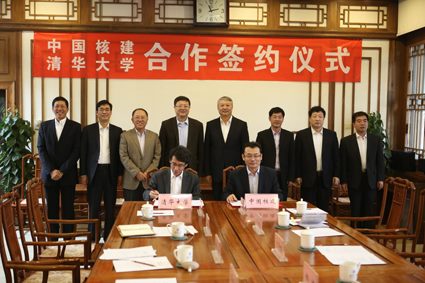Working together for high-temperature reactors
21 March 2014
High-temperature gas-cooled reactor projects have been boosted by a new agreement between CNECC and Tsinghua University, while US and European reactor initiatives are working on a memorandum of understanding.
 |
Tsinghua University and CNECC sign up for continued cooperation
(Image: Tsinghua University) |
For over a decade, China Nuclear Engineering and Construction Corporation (CNECC) and Tsinghua University have been working together on the design, construction and commercialisation of HTGR technology. The new agreement aims to further cooperation between the two partners in both international and domestic marketing of the advanced reactor technology and is described by CNECC as an important milestone in its commercialisation. The agreement was signed in a ceremony at the university, attended by senior figures from the nuclear industry, academia and politics.
Today's designs for high-temperature reactors can trace their ancestry to several reactors developed during the 1960s and 1970s. Capable of delivering high-temperature steam for industrial uses, or for electricity generation, they use silicon carbide-coated 'pebbles' of uranium fuel. Such reactors offer inherent safety characteristics and are small enough to be factory-built, offering the opportunity to build as many modules as needed.
Although various HTGR projects have been under development around the world over the years, China's HTGR project is currently the closest to commercial realisation. Construction work began on two demonstration HTGR units at Shidaowan, Shandong province, in late 2012, with Tsinghua University-CNECC joint venture Chinergy the main contractor for the nuclear island. The plant's twin HTR-PM units will drive a single 210 MWe turbine. Eighteen further units are proposed for the site.
US-European MoU on table
Meanwhile, the US-based Next Generation Nuclear Plant (NGNP) Alliance and the European Nuclear Cogeneration Industrial Initiative (NC2I) are working on a memorandum of understanding (MoU) that would pave the way for collaboration on development, demonstration and deployment of HTGR systems.
Both groups aim to enable commercialisation of HTGR technology, and say they are setting targets to build and demonstrate installations in energy-intensive industries over the next ten years. Following a three-day meeting between the two bodies, they have said that they are to work on an MoU covering areas including the development of a joint vision, business plan and roadmap, establishing an international licensing framework, and supporting joint research beneficial to worldwide commercialisation of their units.
Researched and written
by World Nuclear News